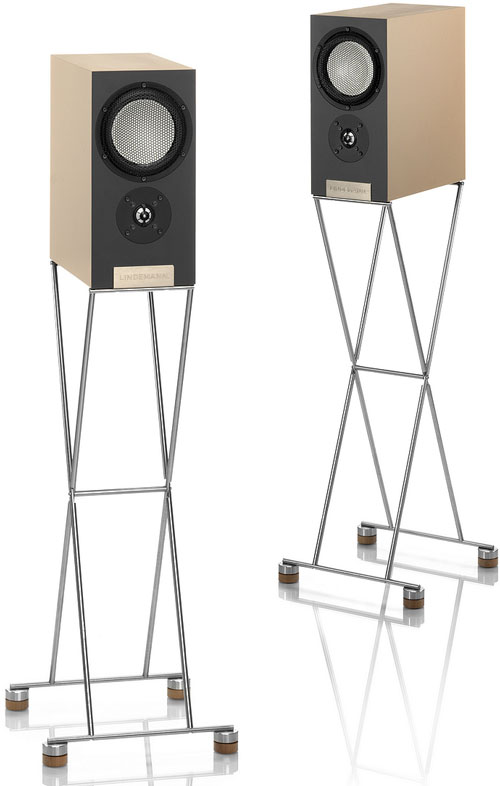Lindemann Audiotechnik was founded in 1992 by Norbert Lindemann. From the start the company’s goal has been to reproduce lifelike music in the traditions of the high fidelity pioneers of the 50s and 60s. They set out to use the latest technologies to produce music reproduction that conveys the emotion and immediacy of a live performance.
Their first product was an integrated amp, AMP1. While popular in their homeland, their breakthrough product was the AMP4. In 1999, they became one of the world’s first companies to produce a CD player with an upsampling DAC. This began the long line of CD and SACD players by Lindemann that have been so well known for their analogue and musical sound.
This is probably why when I think of Lindemann, I first think of SACD/CD players, and then amplifiers. I have to admit that until the 2nd (2011) California Audio Show I didn’t even know they made speakers, but was really impressed with how the BL-10 stand-mounted mini-monitor sounded. I heard them again at RMAF and they sounded even better; in fact the Lindemann room was one of the best- sounding rooms at that show.
Lindemann says these new speakers are based on 30 years of experience and passion for building loudspeakers. The company’s Birdland loudspeaker series was introduced early in 2009, and comprises the latest generation of ceramic drivers that are all custom made to Lindemann’s specifications. The first two models were the BL-20 and BL-30, and in 2011 they released the BL-10 stand-mounted mini-monitor at 2011 CES and followed up with the new BL-25 floorstander later that year.
The BL-10 is an all-out attempt supposedly at a compact speaker with high efficiency and utmost resolution. Lindemann hopes these speakers will become an industry benchmark for speakers designed to play in smaller rooms. They state on their website that no compromises were accepted in pursuit of this goal.
Description
There are two things I can say for sure about these speakers. First is that with the right amplification, in a smaller room, they sure can make beautiful music. Second, they use the very latest scientific, computer, and engineering design methods. Lindemann claims that it uses only the best of today’s available materials, including ceramic midrange drivers from Accuton of Germany, ceramic-coated magnesium dome and neodymium tweeters from Eton of Germany, copper foil inductors from Mundorf of Germany, Nextgen binding posts form WBT of Germany, handmade Master Reference tweeter capacitors from the UK, and Lindemann’s “Kind of Blue”, cryogenically treated pure copper internal wiring.
The midrange ceramic cone drivers are the latest generation from Accuton, and were co-developed by Lindemann and Accuton. These drivers have 30% more mass and a larger voice coil and magnet. The company claims that they are extremely stiff and light weight, giving the speakers a potential for outstanding resolution and efficiency especially in a small cabinet. Lindemann admits that these drivers also present a great challenge to speaker designers, since they are very unforgiving of weaknesses in crossover and cabinet design.
The first order crossover in the Lindeman BL-10, called the “Intelligent Minimum Phase Crossover”, does not force the drivers to maintain a specific transfer function as with a “Butterworth” or “Bessel”. Instead, Lindemann claims their slopes are derived from the natural transfer function of the drivers that have been modified by computer simulation. They claim this delivers perfect frequency and time-domain performance by having just a single component in the signal path of the midrange driver.
The cabinets of these loudspeakers are really quite different from anything I am aware of. They are as dead as any speaker cabinet I know of and they are very light at the same time. This flies in the face of both those who prefer high mass, dead-as-possible cabinets and those who use light weight, thin walled cabinets, that resonate with the sound. Lindemann has designed a speaker that seems to be right in the middle of those two design theories: Relatively light cabinets but with very stiff walls.
Lindemann says it took a great deal of research to optimize the cabinet as a critical component of the speaker system. On their web site they say they tested many cabinet materials for energy storage, resonance, and damping. The low density and high stiffness of the cabinet is accomplished by using a dual-cabinet type of construction, in which a 9 mm birch plywood, 4 mm cork, then another section of 9 mm birch plywood is used. The exterior surface uses 2 mm thick, durable, furniture grade linoleum sourced from Switzerland, bringing the total wall thickness to 24 millimeters. Norbert’s philosophy is straightforward – the lighter and stiffer one’s cabinet is, the less energy stored in the cabinet walls.
Due to the layer of cork, the outer housing is not directly bonded to the interior but sort of “floats” over the cork surface; this is why very few vibrations can be felt on the outside when music is played. Lindemann also uses a small amount of a product called, Twaron “Angel Hair” that is applied to the interior. The use of Twaron Angel Hair is to absorb high frequency energy inside the cabinet and is the same lightweight material used to help dampen the bodies of Airbus jet aircrafts. Well, I told you these speakers were developed with highly scientific engineering principles , very German.
- (Page 1 of 4)
- Next page →
